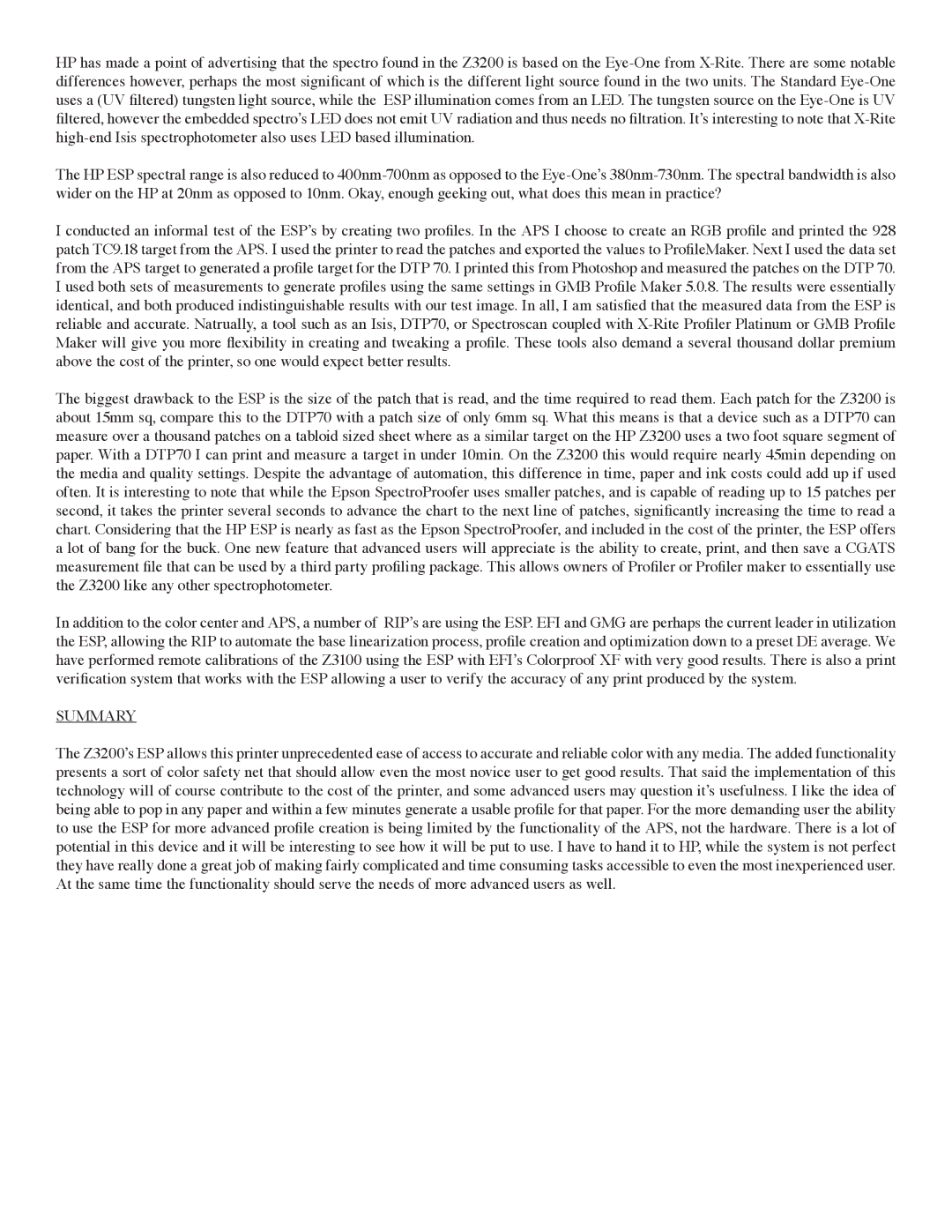HP has made a point of advertising that the spectro found in the Z3200 is based on the
The HP ESP spectral range is also reduced to
I conducted an informal test of the ESP’s by creating two profiles. In the APS I choose to create an RGB profile and printed the 928 patch TC9.18 target from the APS. I used the printer to read the patches and exported the values to ProfileMaker. Next I used the data set from the APS target to generated a profile target for the DTP 70. I printed this from Photoshop and measured the patches on the DTP 70. I used both sets of measurements to generate profiles using the same settings in GMB Profile Maker 5.0.8. The results were essentially identical, and both produced indistinguishable results with our test image. In all, I am satisfied that the measured data from the ESP is reliable and accurate. Natrually, a tool such as an Isis, DTP70, or Spectroscan coupled with
The biggest drawback to the ESP is the size of the patch that is read, and the time required to read them. Each patch for the Z3200 is about 15mm sq, compare this to the DTP70 with a patch size of only 6mm sq. What this means is that a device such as a DTP70 can measure over a thousand patches on a tabloid sized sheet where as a similar target on the HP Z3200 uses a two foot square segment of paper. With a DTP70 I can print and measure a target in under 10min. On the Z3200 this would require nearly 45min depending on the media and quality settings. Despite the advantage of automation, this difference in time, paper and ink costs could add up if used often. It is interesting to note that while the Epson SpectroProofer uses smaller patches, and is capable of reading up to 15 patches per second, it takes the printer several seconds to advance the chart to the next line of patches, significantly increasing the time to read a chart. Considering that the HP ESP is nearly as fast as the Epson SpectroProofer, and included in the cost of the printer, the ESP offers a lot of bang for the buck. One new feature that advanced users will appreciate is the ability to create, print, and then save a CGATS measurement file that can be used by a third party profiling package. This allows owners of Profiler or Profiler maker to essentially use the Z3200 like any other spectrophotometer.
In addition to the color center and APS, a number of RIP’s are using the ESP. EFI and GMG are perhaps the current leader in utilization the ESP, allowing the RIP to automate the base linearization process, profile creation and optimization down to a preset DE average. We have performed remote calibrations of the Z3100 using the ESP with EFI’s Colorproof XF with very good results. There is also a print verification system that works with the ESP allowing a user to verify the accuracy of any print produced by the system.
SUMMARY
The Z3200’s ESP allows this printer unprecedented ease of access to accurate and reliable color with any media. The added functionality presents a sort of color safety net that should allow even the most novice user to get good results. That said the implementation of this technology will of course contribute to the cost of the printer, and some advanced users may question it’s usefulness. I like the idea of being able to pop in any paper and within a few minutes generate a usable profile for that paper. For the more demanding user the ability to use the ESP for more advanced profile creation is being limited by the functionality of the APS, not the hardware. There is a lot of potential in this device and it will be interesting to see how it will be put to use. I have to hand it to HP, while the system is not perfect they have really done a great job of making fairly complicated and time consuming tasks accessible to even the most inexperienced user. At the same time the functionality should serve the needs of more advanced users as well.
